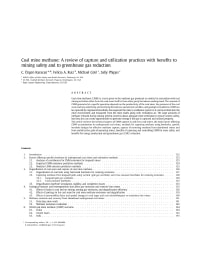Mining Publication: Coal Mine Methane: A Review of Capture and Utilization Practices with Benefits to Mining Safety and to Greenhouse Gas Reduction
Original creation date: May 2011
Authors: C� Karacan, FA Ruiz, M Cote, S Phipps
NIOSHTIC2 Number: 20038813
Int J Coal Geol 2011 May; 86(2-3):121-156
Coal mine methane (CMM) is a term given to the methane gas produced or emitted in association with coal mining activities either from the coal seam itself or from other gassy formations underground. The amount of CMM generated at a specific operation depends on the productivity of the coal mine, the gassiness of the coal seam and any underlying and overlying formations, operational variables, and geological conditions. CMM can be captured by engineered boreholes that augment the mine's ventilation system or it can be emitted into the mine environment and exhausted from the mine shafts along with ventilation air. The large amounts of methane released during mining present concerns about adequate mine ventilation to ensure worker safety, but they also can create opportunities to generate energy if this gas is captured and utilized properly. This article reviews the technical aspects of CMM capture in and from coal mines, the main factors affecting CMM accumulations in underground coal mines, methods for capturing methane using boreholes, specific borehole designs for effective methane capture, aspects of removing methane from abandoned mines and from sealed/active gobs of operating mines, benefits of capturing and controlling CMM for mine safety, and benefits for energy production and greenhouse gas (GHG) reduction.

NIOSHTIC2 Number: 20038813
Int J Coal Geol 2011 May; 86(2-3):121-156
- A CART Technique to Adjust Production from Longwall Coal Operations under Ventilation Constraints
- Historical Development of Technologies for Controlling Methane in Underground Coal Mines
- Methane Control by Isolation of a Major Coal Panel - Pittsburgh Coalbed
- Methane Drainage: Experience With Hydraulic Stimulation Through Slotted Casing
- Methane Emissions from Four Working Places in the Beckley Mine, Raleigh County, W. Va.
- A Numerical Evaluation on the Effects of Impermeable Faults on Degasification Efficiency and Methane Emissions During Underground Coal Mining
- Removing Methane (Degasification) from the Pittsburgh Coalbed in Northern West Virginia
- Rotary Drilling Techniques Used in the Beckley Coalbed
- Three Coal Mine Gob Degasification Studies Using Surface Boreholes and a Bleeder System
- Two-Phase Flow in Coalbeds